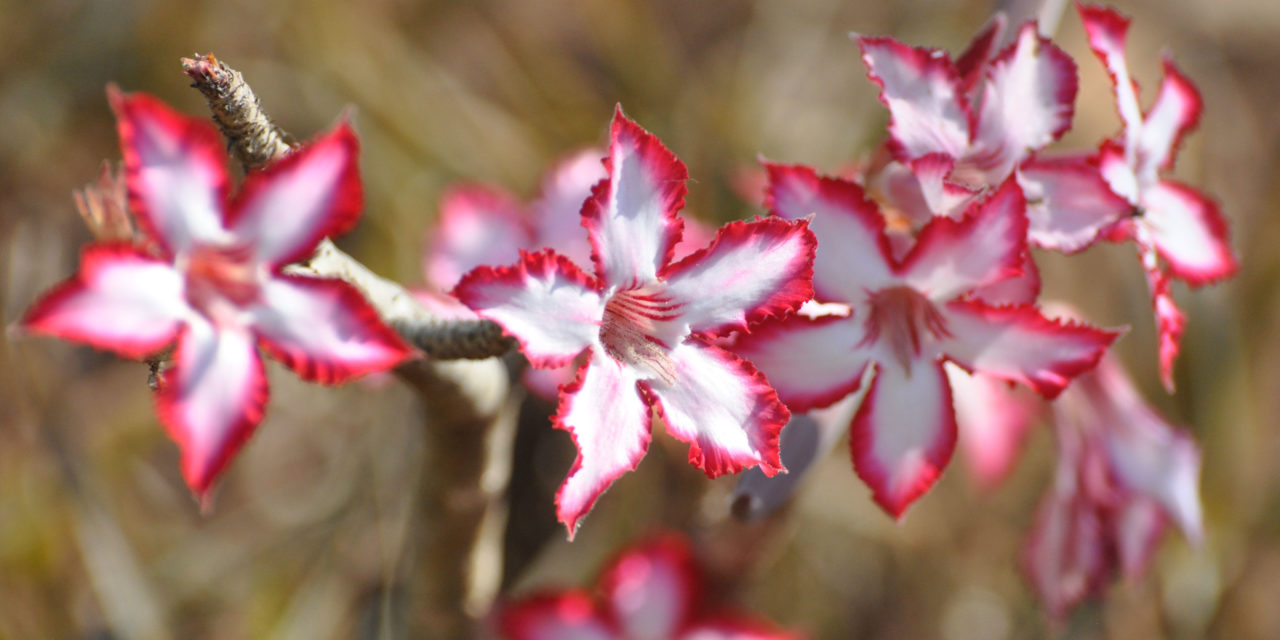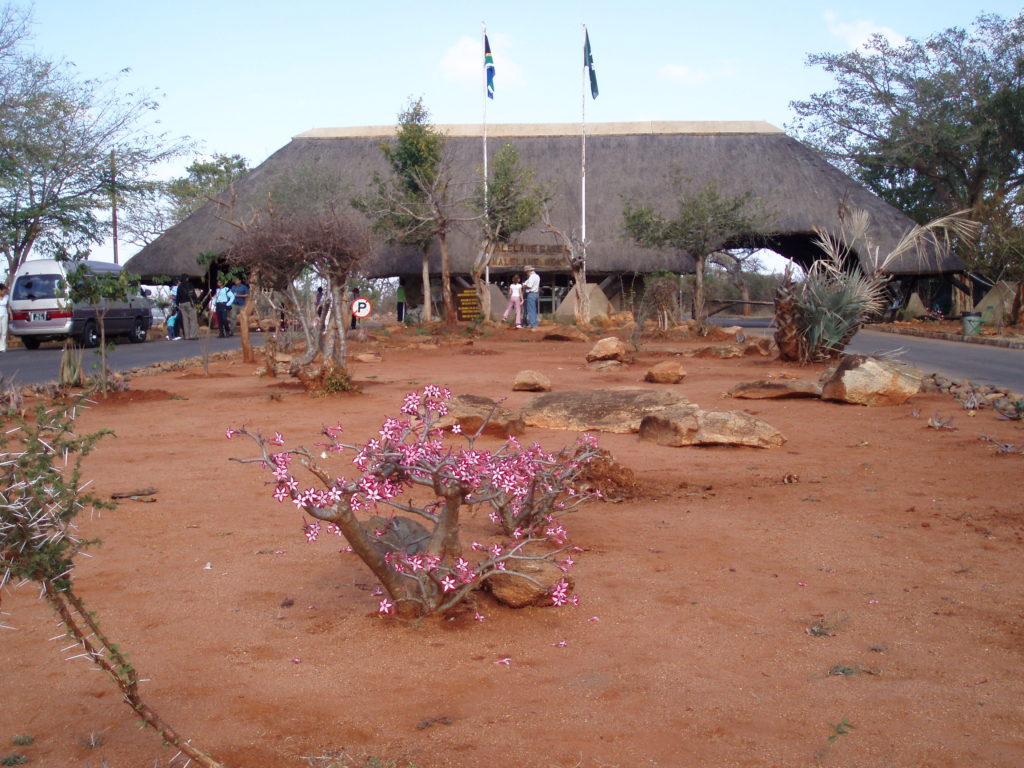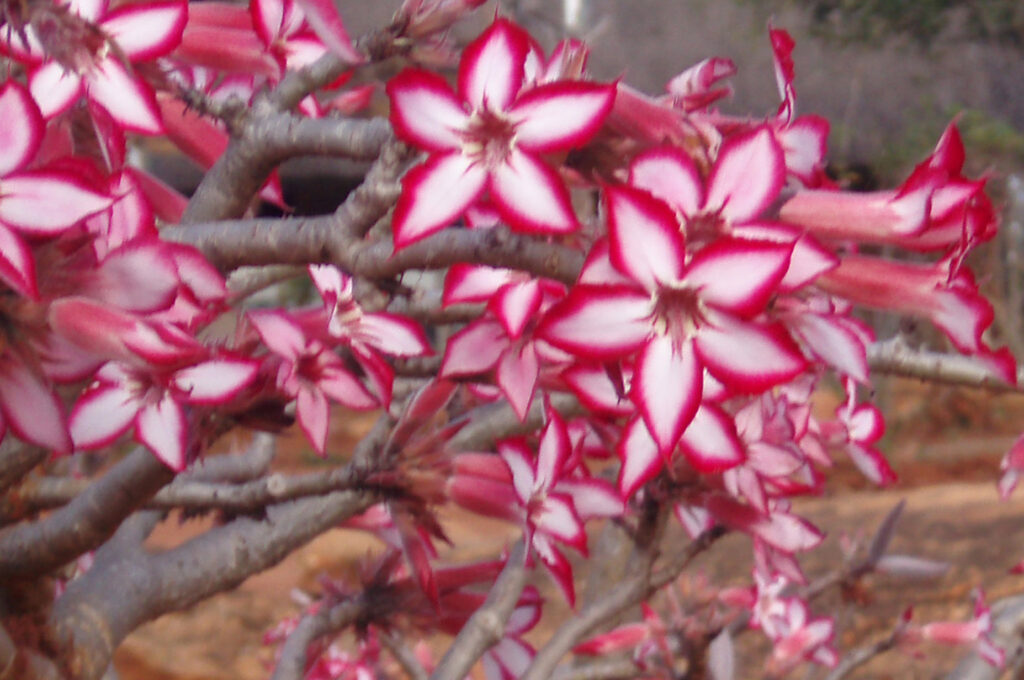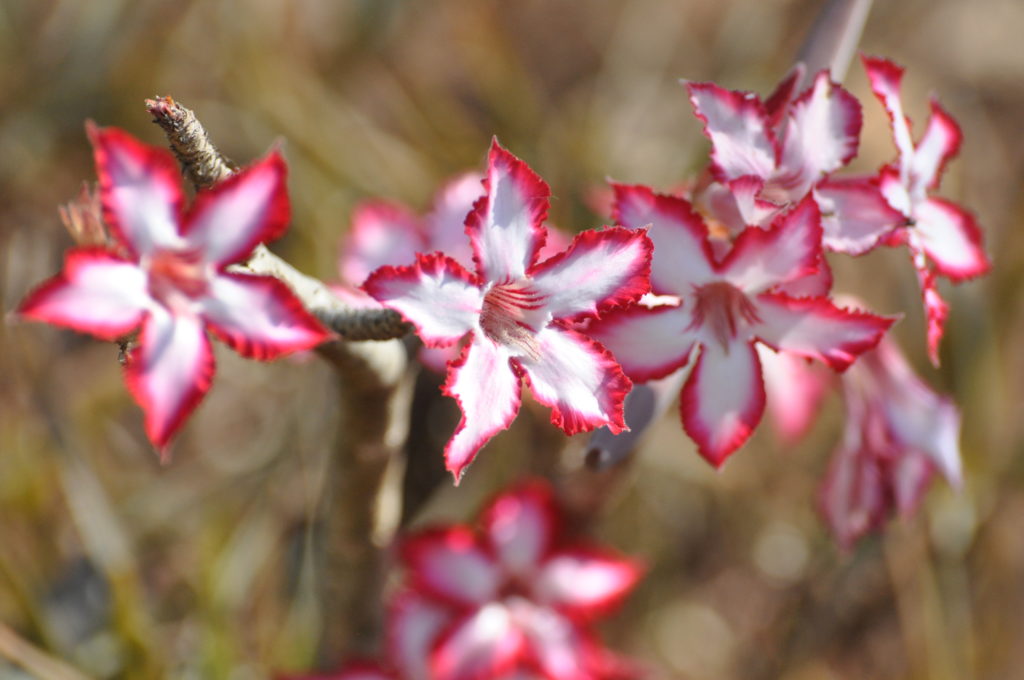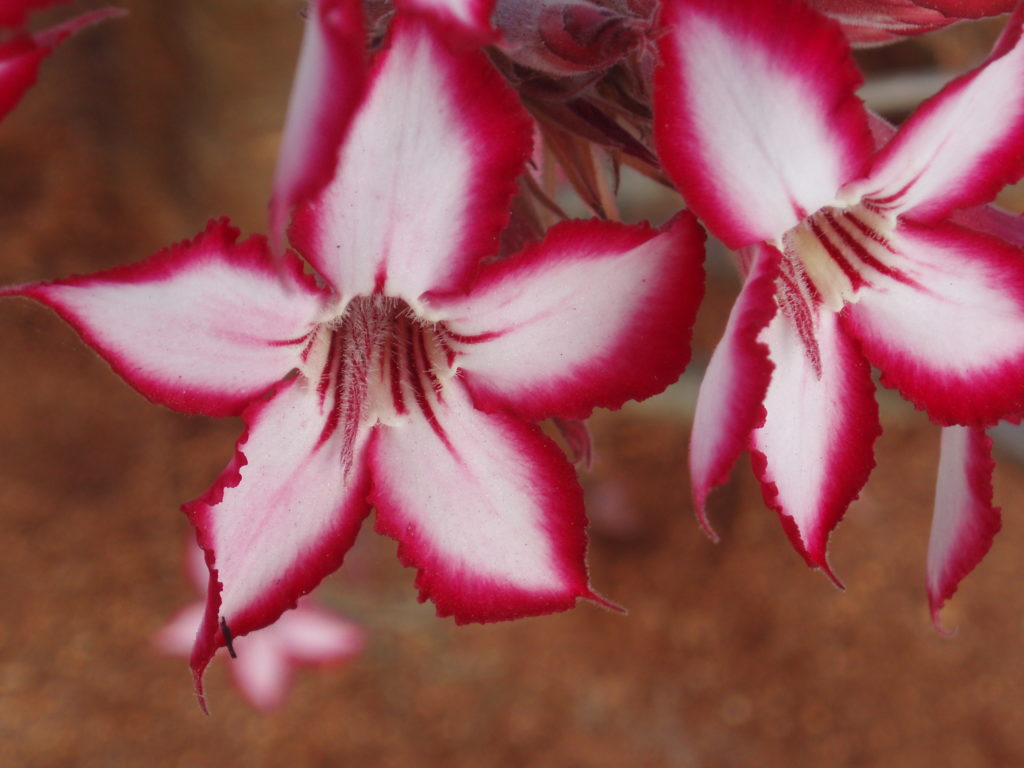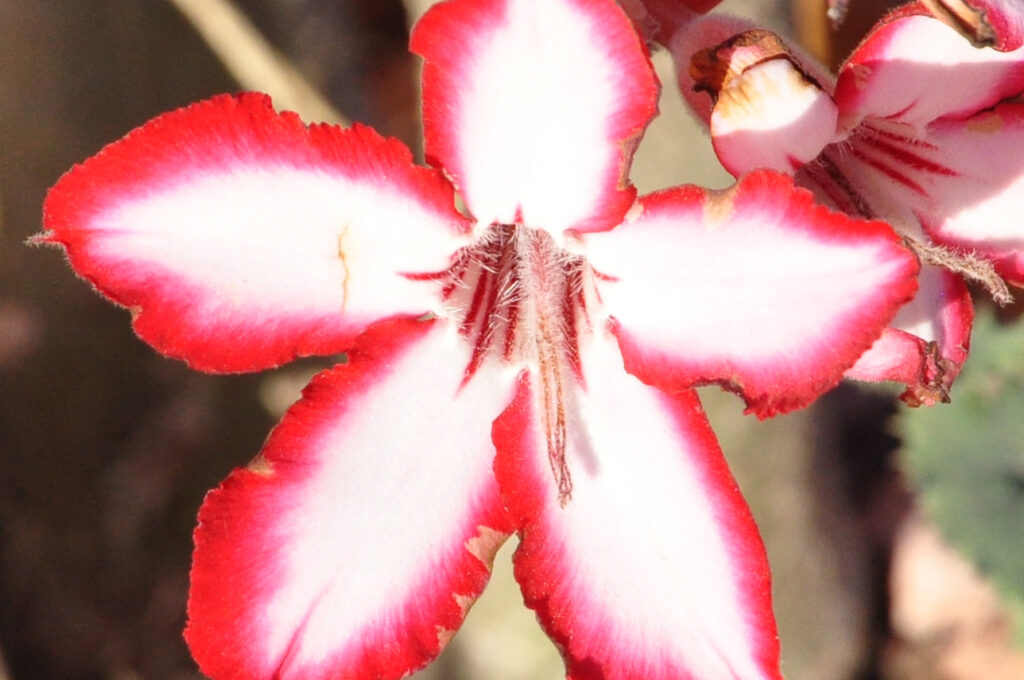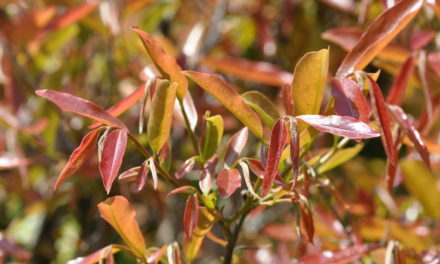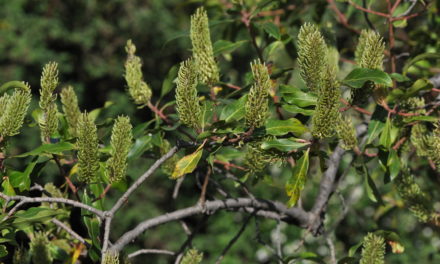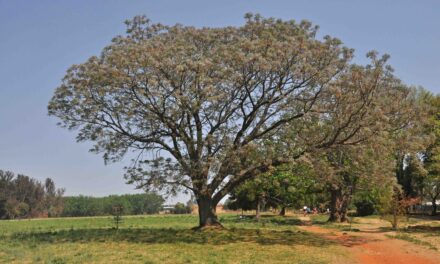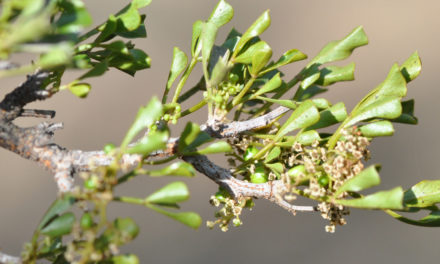Adenium multiflorum
General Info – summary
This spineless Plant has a smooth, grey-green bark and thickset succulent stem with watery toxic latex, rarely reaching 3,6m high. Simple, entire, hairless Leaves have axillary glands and entire margins. Bisexual, regular Flowers have white petals enclosed in red. Anthers 4 (filaments short). 1 pistil with a superior ovary & short style. Long Fruit with grooved, paired follicles and many wind dispersed seeds.
Description
Previous Names: Adenium obesum, Adenium obesum var. multiflorum.
SA Tree No. 647.3.
Common names: (Afr) Impalalelie. (Eng) Impala-lily, Impala Lily, Kudu Lily, Sabi Star. (isiZulu) Ihlungunyembezi, Isigubengubu. (siSwati) Sisila-semphala. (Tshivenda) Tshivhuyu-dumbu. (Xitsonga) Xihudumbu.
Family Apocynaceae (Oleander or impala lily: Adenium multiflorum family). This family includes the exotic genera Oleander and Plumeria (Frangipani). Indigenous genera containing trees on this site include Acokanthera, Adenium, Carissa, Rauvolfia and Tabernaemontana. Currently the family has 366 genera and in excess of 5 000 species. In South Africa, there are 90 genera and about 700 species. All have milky or clear sap. The simple, entire and pinnately veined Leaves are usually opposite and may have stipules situated between the petiole and the stem. The Inflorescence is usually a cyme (a broad, more or less flat-topped, determinate flower cluster, with central flowers opening first). The regular and bisexual Flowers are usually bracteate. The Calyx has 4-5, usually free sepals and the 4-5 Petals are joined – at least at the base of the staminal column. A corona (an extension) is often present either on the corolla or arising from the base of the staminal column. The 4-5 Stamens are variously located and have anthers with 2 pollen sacs. The superior to half-inferior Ovary has 2 carpels. Fruit is various. The often-compressed Seeds may have a tuft of silky hair at the micropylar end. The micropyle (a small opening in the surface of an ovule, through which the pollen tube penetrates is often visible as a small pore in the ripe seed. During germination, the seedling’s radicle – embryonic root – emerges through the micropyle).
Name derivation: Adenium is either named after the district in South Yemen OR fat – referring to the succulent stems. multiflorum – many flowers. The type specimen came from Tete in northern Mozambique. Other species of Adenium are located in southern Africa. They include A. oleifolium and A. swazicum. The genus Adenium has about 100 species worldwide. This is a genus of succulent shrubs and small trees found in Africa, Arabia and Socotra (island off the coast of Somalia – part of the archipelago of the same name). These plants have swollen stems and usually simple leaves. They differ from Adenia that usually have twining stems.
Conservation: National Status: L C. (Least Concern). Assessed: 2008 (J.E. Victor and D. Raimondo). This plant is widespread and not declining. It is common in the Kruger Park and thus partially protected. Beyond our borders, it is on the Red Data list.
Tree
This thickset and spineless plant is usually a shrub up to 1,5m high (photo 04) and occasionally a Tree up to 3,6m. Here the Stem (main axis of the plant) is thick, swollen and succulent (with some more than normally thickened parts). There may be more than one stem arising from a Tuber (swollen underground stem, which is a storage and regenerative organ. This helps survival during dry winter months). The grey-green and smoothish Bark (photo 07) may be slightly pink and has much white poisonous watery latex present that may be exuded from damaged parts. The thick and stumpy Branches may be almost vertical (photo 04).
- 04. 2008/08/10. Malalane Gate KNP. Photo: David Becking.
- 07. 2008/08/10. Malalane Gate KNP. Photo: David Becking.
Leaves
On this deciduous plant (here leaves absent for most of the year and are shed before the flowers appear), the fleshy, succulent and hairless Leaves are clustered towards the ends of branches. They are spirally arranged and simple (have a single blade which may have incisions that are not deep enough to divide the blade into leaflets). The smooth leaves are up to 12 x 8cm and oblong to obovate (the reverse of ovate, the terminal half is broader than the basal). The leaves are slightly fleshy, especially when young. The Blade may be tinged with pink and is glossy green to bluish green above, and paler dull green below. The Midrib is often pinkish and is prominent on both surfaces. There are 6-11 pairs of indistinct lateral Veins, which are more visible above. Conspicuous axillary (in the axil – growing between stem and leaf) Glands are present – several in each axil. The Apex is rounded or notched. The wavy Margin is entire (with a continuous margin, not in any way indented). The tapering Base is decurrent (leaf blades that partly wrap or have wings around the stem or petiole). When present the Petiole (leaf stalk) may be obscured or up to 0,5cm long. Stipules (basal appendage of the petiole) are tiny or absent.
Flowers
The very impressive, almost hairless, sweet-scented Flowers emerge in winter – usually before the leaves appear. Each magnificent, eye-catching flower is bisexual and actinomorphic (Regular, symmetrical. Flowers are vertically divisible into similar halves by more than 1 plane passing through the axis). The flowers are up to 4,5cm in diameter. Flowers occur in few-flowered terminal heads, or contracted cymes (a broad, more or less flat-topped, determinate flower cluster, with central flowers opening first). They are 5-merous (parts of the flower in fives). The Calyx has 5 Sepals which are divided almost to the base. The white funnel-shaped Corolla tube is streaked with red or pink (photo 06). Here the 5 Petal lobes are broad, spreading horizontally from the tube and have a crinkled, uneven margin (photos 515 & 348). They are white to pale pink with broad red or rose pink tinged margins. Each lobe is as long as the tube and is lanceolate. Petal lobes overlap to the right (photo 348). Occasionally all white flowers appear. The 4 Stamens are attached to the widened part of the corolla tube. Filaments are very short. The 4-locular lanceolate Anthers have bases shaped like an arrowhead and fused are with the style, and end with a long, hairy appendage (photo 348). Pollen is only produced in the upper portion. There is a single Pistil (a unit of the Gynoecium, the female element of the flower, composed of the Ovary, Style) containing a superior, hairless Ovary with many ovules and 2 free Carpels. The single short cylindrical Style has a capitate (formed like a head) Stigma and possesses a basal rim. (May-Sep).
- 515. 2014/09/10. Lower Sabi KNP. Photo: David Becking.
- 06. 2008/08/10. Malalane Gate KNP. Photo: David Becking
- 348. 2014/09/01. Mapungubwe NP. Photo: David Becking. enlarged.
Fruit
The Fruit is a paired Follicle (dry dehiscent fruit, which is almost cylindrical and pod-like, that opens only on the front side and is the product of the single pistil). The cigar-shaped fruit is up to 15 x 2cm but usually smaller and covered with dense pinkish-grey short soft hairs when young. The follicles taper at each end and are at right angles to the supporting stem. When mature the fruit eventually splits releasing many long, narrow, light brown and grooved Seeds. Each seed has a tuft of silky golden-brown hairs at each end – enhancing wind dispersal. (Jul-Jan).
Distribution & Ecology
These Plants are located in NE KwaZulu-Natal, Mpumalanga e.g. Shingwedzi in the Kruger Park, and Limpopo. Beyond South Africa, they occur in Botswana, SiSwati (Swaziland), central and southern Mozambique, Zambia, Malawi and into Tropical Africa. Grazing often prevents the plants from growing very high. Consumers include Impala, Kudu and Rhino. Baboons may uproot whole plants to feed on the tuberous rootstocks. Plants are common at low altitudes on rocky ridges and brackish flats. They grow in sandy soil, in dry woodland, open grassland or sandy woodland.
Ethnobotany
These plants may have toxic properties that are used as a fish and arrow poison. The milky Latex extracted from the bark contains Cardiac glycoside – a toxic alkaloid that affects heart functioning. However, many animals do consume the plants. Seeds germinates easily but must not be over-watered. Grow these plants in a frost-free well-drained environment or indoors. In warm, dry positions, they make an exceptional container plant. Plants require space for root development. They do best in full sun and good drainage. Plants are susceptible to frost and overwatering but need water when in leaf. Local medicine makes use of this plant.
References
Boon, R. 2010. Pooley’s Trees of eastern South Africa. Flora and Fauna Publications Trust, Durban.
Burrows, J.E., Burrows, S.M., Lotter, M.C. & Schmidt, E. 2018. Trees and Shrubs Mozambique. Publishing Print Matters (Pty) Ltd. Noordhoek, Cape Town.
Coates Palgrave, M. 2002. Keith Coates Palgrave Trees of Southern Africa, edn 3. Struik, Cape Town.
Lawrence, G. H. M, 1951. Taxonomy of Vascular Plants. The Macmillan Company, New York. Tenth Printing 1965.
Palmer, E. & Pitman, N. 1972. Trees of southern Africa. Balkema, Amsterdam, Cape Town.
Schmidt, S. Lotter, M. & McCleland, W. 2002. Trees and Shrubs of Mpumalanga and the Kruger National Park. Jacana, Johannesburg.
van Wyk, B. & van Wyk, P. 1997 Field guide to Trees of Southern Africa. Struik, Cape Town.
Victor, J.E. & Raimondo, D. 2008. Adenium multiflorum Klotzsch. National Assessment: Red List of South African Plants version. Accessed on 2025/03/13.
https://en.wikipedia.org/wiki/Succulent_plant
http://www.plantzafrica.com/plantab/adeniummultiflor.htm
https://en.wikipedia.org/wiki/Adenium_multiflorum
http://posa.sanbi.org/flora/browse.php?src=SP

